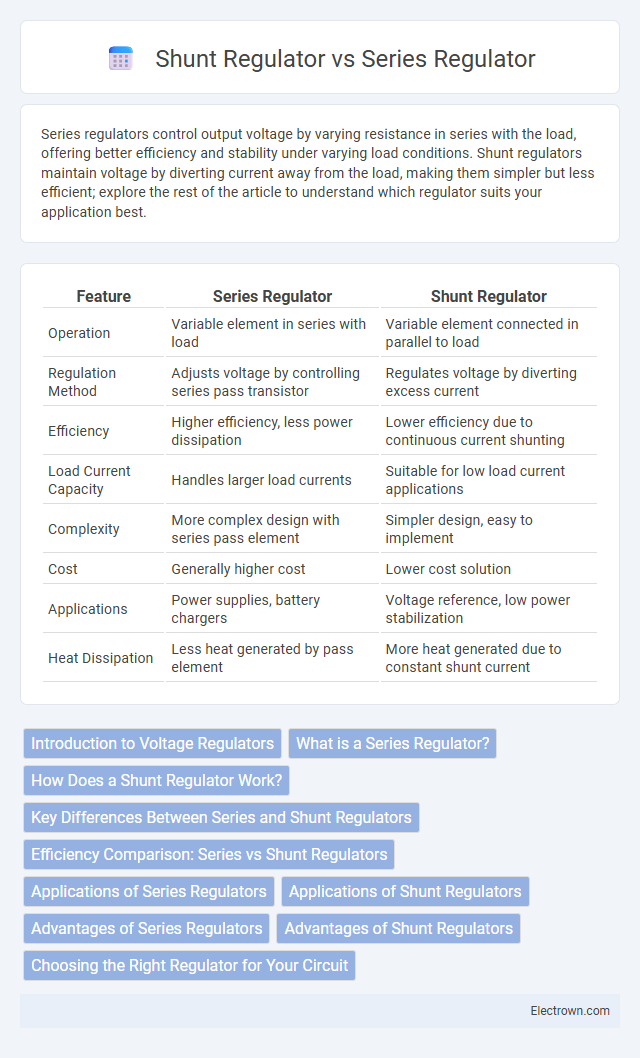Series regulators control output voltage by varying resistance in series with the load, offering better efficiency and stability under varying load conditions. Shunt regulators maintain voltage by diverting current away from the load, making them simpler but less efficient; explore the rest of the article to understand which regulator suits your application best.
Table of Comparison
| Feature | Series Regulator | Shunt Regulator |
|---|---|---|
| Operation | Variable element in series with load | Variable element connected in parallel to load |
| Regulation Method | Adjusts voltage by controlling series pass transistor | Regulates voltage by diverting excess current |
| Efficiency | Higher efficiency, less power dissipation | Lower efficiency due to continuous current shunting |
| Load Current Capacity | Handles larger load currents | Suitable for low load current applications |
| Complexity | More complex design with series pass element | Simpler design, easy to implement |
| Cost | Generally higher cost | Lower cost solution |
| Applications | Power supplies, battery chargers | Voltage reference, low power stabilization |
| Heat Dissipation | Less heat generated by pass element | More heat generated due to constant shunt current |
Introduction to Voltage Regulators
Voltage regulators maintain a constant output voltage despite variations in input voltage or load conditions, essential for protecting electronic circuits. Series regulators control output voltage by varying the resistance of a pass transistor in series with the load, providing high efficiency and precise regulation. Shunt regulators regulate voltage by diverting current through a parallel element, offering simplicity and cost-effectiveness but typically lower efficiency compared to series regulators.
What is a Series Regulator?
A Series Regulator is a voltage regulation device that controls output voltage by placing a transistor in series with the load, adjusting its resistance to maintain a stable voltage despite input fluctuations. It offers excellent load regulation and low output noise, making it ideal for circuits requiring precise voltage control. This regulator typically operates with a pass transistor that conducts current in series, ensuring efficient voltage stabilization under varying load conditions.
How Does a Shunt Regulator Work?
A shunt regulator maintains voltage by diverting excess current through a parallel path, effectively stabilizing the output voltage across the load. It operates by comparing the output voltage to a reference voltage and adjusting the current flow through a transistor or Zener diode to shunt the surplus current to ground. This simple feedback mechanism ensures a constant voltage despite variations in input voltage or load conditions.
Key Differences Between Series and Shunt Regulators
Series regulators maintain voltage stability by regulating current flow through a transistor connected in series with the load, providing higher efficiency and better voltage regulation under varying load conditions. Shunt regulators operate by diverting excess current through a parallel path using a transistor or Zener diode, offering simpler design but lower efficiency and limited current handling. The key differences include their topology, power dissipation methods, and suitability for high versus low current applications.
Efficiency Comparison: Series vs Shunt Regulators
Series regulators offer higher efficiency than shunt regulators by regulating output voltage through a transistor in series with the load, minimizing power dissipation especially under varying load conditions. Shunt regulators, which operate by diverting excess current away from the load, tend to waste more power and are less efficient, particularly at higher load currents. Your choice of regulator impacts overall power consumption and thermal management due to these fundamental efficiency differences.
Applications of Series Regulators
Series regulators are widely used in applications requiring precise voltage control and low output noise, such as powering analog circuits, microprocessors, and communication devices. They excel in battery-powered systems, offering efficient voltage regulation with minimal power dissipation. Due to their ability to handle variations in input voltage while maintaining a stable output, series regulators are also favored in power supplies for sensitive electronic equipment.
Applications of Shunt Regulators
Shunt regulators are commonly used in low-power applications such as voltage reference circuits, power supply filters, and simple voltage stabilization tasks. Their ability to maintain a constant voltage by diverting excess current makes them ideal for protecting sensitive components in battery chargers and signal processing circuits. Your electronic devices benefit from shunt regulators' efficient regulation in scenarios requiring minimal current handling.
Advantages of Series Regulators
Series regulators offer superior voltage regulation by efficiently maintaining a stable output voltage despite variations in input voltage or load current. Their design results in lower power dissipation and enhanced thermal management compared to shunt regulators, making them ideal for high-current applications. You benefit from improved reliability and energy efficiency, ensuring consistent performance in sensitive electronic devices.
Advantages of Shunt Regulators
Shunt regulators offer simplicity and cost-effectiveness by controlling voltage through a parallel connection, providing effective voltage regulation with minimal components. They excel in applications with low current demands, as their design allows quick response to voltage fluctuations and improved noise reduction. Due to their ability to operate without complex feedback mechanisms, shunt regulators are ideal for stabilization in low-power circuits and reference voltage generation.
Choosing the Right Regulator for Your Circuit
Selecting the right voltage regulator depends on the specific requirements of your circuit, such as current load, efficiency, and voltage stability. Series regulators offer higher efficiency for circuits with varying loads by placing the regulator in series with the load, minimizing power dissipation. Shunt regulators, while simpler and cost-effective for low current applications, maintain voltage by diverting excess current but may result in higher power loss, making them suitable primarily for low-power, low-voltage stabilization tasks.
Series Regulator vs Shunt Regulator Infographic

 electrown.com
electrown.com